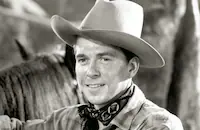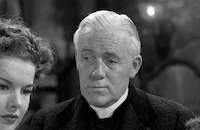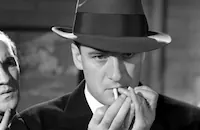Smashing the Money Ring

Brief Synopsis
Cast & Crew
Terry Morse
Ronald Reagan
Margot Stevenson
Eddie Foy Jr.
Joe Downing
Charles D. Brown
Film Details
Technical Specs

Synopsis
Unknown to prison authorities, the printing of counterfeit money has become a flourishing industry within the walls of their own institution. When gangster Dice Matthews tries to force casino owner Steve Parker to distribute the bills aboard his gambling ship, the Kismet , Parker anonymously notifies the police and then, to avoid the clutches of the mob, gets sentenced to prison for slugging a cop. Parker's tip alerts the secret service, and Lieutenant Brass Bancroft and his pal Gabby are assigned to the case. After Dice is arrested in a gambling raid and sentenced to the same prison as Parker, Brass goes undercover to contact Dice. Posing as a tough convict, Brass wins Dice's confidence, and the gangsters include him on a planned escape. Meanwhile, Parker tells his daughter Peggy that he plans to go straight, but the next morning, he is found murdered in his cell. Peggy remembers that Davis, a guard, overheard their conversation, but before Parker's murder can be solved, Brass and Dice break out of jail. On the road to meet the brains behind the counterfeiting ring, Dice tells Brass that the bills are counterfeited in the prison and then smuggled out in stacks of prison newspapers. Dice then introduces Brass to Davis, the head of the ring, who has learned that Brass is a secret service agent. Davis shoots both Dice and Brass, but Brass feigns death and escapes. Brass then returns to the prison to arrest Davis, who dies in a hail of gunfire.

Director
Terry Morse
Cast

Ronald Reagan

Margot Stevenson
Eddie Foy Jr.
Joe Downing

Charles D. Brown
Joe King

William Davidson
Charles Wilson

Elliott Sullivan

John Hamilton
Sidney Bracy
Jack Wise

Jack Mower
Don Turner
Ralph Sanford
Dick Rich
Max Hoffman Jr.
Nat Carr
Frank Mayo
John Harron

Don Douglas
George Chesebro
Al Herman

Tom Wilson
Dutch Hendrian

Lee Phelps

John Ridgely
Jim Pierce
Charles Trowbridge
Milton Frome

Ralph Dunn
Pat O'malley
Edward Hearn
Monte Vandergrift
Bob Perry
Crew
Milo Anderson
Anthony Coldeway
Jonathan Finn
Bryan Foy
Arthur Lueker
Frank Magee
Charles Novi
Lou O'connell
Charles Perry
Arthur Ripley
Raymond Schrock
Dolph Thomas
James Van Trees
Jack L. Warner

Film Details
Technical Specs

Articles
Smashing the Money Ring
Studio head Jack Warner had purchased the rights to the unpublished memoirs of William H. Moran, head of the Secret Service from 1917 until 1936. Moran was retained as a technical advisor but, given that most of what he could bring to the table from an espionage standpoint was still highly classified, Warners scribes had to invent the movie plots out of thin air. Smashing the Money Ring was based on the original story "Murder in Sing Sing" by Jonathan Finn, first adapted for Nick Grinde's Jailbreak (1936) only three years earlier. (Finn also authored Lloyd Bacon's post-prison drama Invisible Stripes (1939), starring Humphrey Bogart, George Raft and a young William Holden.) Rushed into production, the Smashing the Money Ring shooting script benefited from on-set rewrites to fill in sundry holes in logic and plotting. Aimed as they were at the matinee market, Hollywood B movies weren't held to the same standards as their classier kin. While prestige films had to hew closely to political guidelines in particular, those defining US neutrality in the years leading up to America's involvement in World War II programmers and serials were allowed to baldly accuse Axis powers of perpetrating acts of global terrorism...all put paid in this context by Brass Bancroft and his comic sidekick Gabby. Arguably the most consistently entertaining and popular asset of the series, Gabby, was played by Eddie Foy, Jr., one of Vaudeville's "Seven Little Foys" and the brother of Bryan Foy, who ran Warner's B unit.
The following year would see an uptake in both Ronald Reagan's career and personal life. In 1940 he played the secondary but pivotal character of George "The Gipper" Gipp in Knute Rockne, All-American (1940) and was George Armstrong Custer to Errol Flynn's Jeb Stuart in Santa Fe Trail. In January, Reagan had proposed to actress Jane Wyman with the persuader of a 32-carat amethyst ring. Wyman's divorce from second husband Myron Futterman had been granted a month earlier and, despite obvious incompatibilities between the two Warners contract players, she accepted Reagan's proposal. The pair had great success following World War II, with Reagan's justifiably celebrated dramatic turn as Drake ("Where's the rest of me?") McHugh in Kings Row (1942) and Wyman's Academy Award® winning performance as Johnny Belinda (1948). By the time Reagan and Wyman were divorced in 1948, he was President of The Screen Actor's Guild and pointed to a bright political future. Less than a decade after they were made, his Brass Bancroft pictures were all but forgotten except by Reagan himself, who used his Hollywood clout to keep them out of Los Angeles theaters and far from the minds of the moviegoing and voting public.
Director: Terry O. Morse
Screenplay: Anthony Coldeway, Raymond Schrock; Jonathan Finn (idea)
Cinematography: James Van Trees; L. William O'Connell (uncredited)
Art Direction: Charles Novi
Music: Bernhard Kaun (uncredited)
Film Editing: Frank Magee
Cast: Ronald Reagan (Lieutenant 'Brass' Bancroft), Margot Stevenson (Peggy Parker), Eddie Foy, Jr. (Gabby Watters), Joe Downing (Dice Mathews), Charles D. Brown (Steve Parker), Joe King (Tom Saxby), William Davidson (Warden Denby), Charles Wilson (Captain Kilrane), Elliott Sullivan (Danny Galloway), John Hamilton (Night Captain)
BW-56m.
by Richard Harland Smith
Sources:
The Films of Ronald Reagan by Tony Thomas
Reagan: The Hollywood Years by Marc Eliot
Dutch: A Memoir of Ronald Reagan by Edmund Morris by Richard Harland Smith

Smashing the Money Ring
Ronald Reagan, 1911-2004 - TCM Remembers Ronald Reagan
Ronald Reagan, the actor turned elected official whose fascinating career saw him develop as a contract player for Warner Brothers studios, to a politician who fulfilled his ambitions by becoming the 40th President of the United States, died at his home in Los Angeles on June 5 after a long battle with Alzheimer's disease. He was 93.
He was born Ronald Wilson Reagan on February 6, 1911 in Tampico, Illinois to John and Nelle Reagan. When Reagan was nine, his family settled down in the small community of Dixon, about 100 miles west of Chicago. After high school, Reagan enrolled in Eureka College, a small Christian school near Peoria. He graduated in 1932 with a degree in Economics, and pursued a career in broadcasting. His first gig was as a part-time announcer at WOC in Davenport, Iowa. Within a year, WOC had merged with its big-sister station, WHO in Des Moines, and Reagan was hired as a sports announcer.
In the spring of 1937, Reagan drove to Southern California to catch the Chicago Cubs in spring training on Santa Catalina Island. While he was in California, he wrangled a screen test and signed a contract for $200 a week with Warner Brothers. His film debut was rather inauspicious; he portrayed a radio announcer in an innocuous comedy Love is on the Air (1937). He made a few more "B" programmers like Hollywood Hotel (also 1937), and Girls on Probation (1938), before getting his first prominent role opposite Bette Davis in the popular tearjerker, Dark Victory (1939).
Although he seldom got credit for being a good actor, there was no denying that Reagan held his own given the right material: Knute Rockne, All American as the doomed Notre Dame football hero George "The Gipper" Gipp, where he delivered the film's immortal line "Win one for the Gipper!"; Santa Fe Trail in which he ably supports Errol Flynn in one of the boxoffice hits of its era (both 1940); Kings Row (1941), featuring one of his finest performances as a small-town playboy whose legs are amputated by a careless surgeon; and Desperate Journey (1942) where he again supported Flynn in an exciting action picture.
Due to his poor eyesight, Reagan didn't see any action in World War II, so the studio heads assigned him to star in a series of patriotic films produced by the First Motion Picture Unit of the Army Air Forces in Culver City. Between 1942-45, Reagan starred in over 400 of these films. After the war, Reagan still found some good roles: The Voice of the Turtle (1947) proved he had a deft hand at light comedy opposite Eleanor Parker; The Hasty Heart (1949) offered another underrated performance as he ably portrayed the Yank in John Patrick's much heralded wartime play; and Storm Warning (1950) was a slick melodrama that cast Reagan as a crusading District Attorney determined to bring the KKK in a small southern town, with the help of Doris Day and Ginger Rogers!
It was around this time that Reagan became involved in politics. In 1947, he began a five-year term as president of the Screen Actors Guild (SAG), and testified in October of that year before the newly formed House Un-American Activities Committee (HUAC). He identified suspected Communists Larry Parks, Howard Da Silva and Alexander Knox, all of whom were subsequently called to testify, and subsequently blacklisted. Later records showed Reagan was so concerned about the Communist influence in Hollywood, that he became an FBI informer.
As Reagan became steeped in his political career, his parts throughout the '50s became inferior: the notorious Bedtime for Bonzo (1951); the coy "sex" comedy She's Working Her Way Through College (1952) that cast him as a college professor who romances a stripper! (Virginia Mayo); Cattle Queen of Montana (1955), a sluggish Western that even the redoubtable Barbara Stanwyck couldn't save; and finally Hellcats of the Navy (1957), a stodgy war picture that would be his only film that co-starred his wife Nancy (Davis).
Television offered some salvation. For eight years, (1954-62), Reagan served as the host of General Electric Theater, a televised series of dramas. He also found a niche as GE's goodwill ambassador to employees and to civic and business groups around the country, furthering his taste and honing his craft as a public official. By the mid '60s, Reagan would move into politics entirely, save for one last film, the thrilling The Killers (1964), Reagan's only known villainous role, as a murderous gangster. That same year, he actively campaigned for Republican Presidential candidate Barry Goldwater, although Goldwater lost to Lyndon B. Johnson.
Reagan whose profile was riding high, had cemented his future as a successful politician. In 1966, he ran against incumbent Governor Pat Brown for the state of California and won, serving successfully for two terms until 1974.
Reagan began an all-out, two-year drive to wrest the 1976 nomination from incumbent Gerald R. Ford, an appointed vice president who became president on the resignation of Nixon. Reagan fell short by a handful of delegates to the Republican national convention. But Ford lost to Jimmy Carter, and Reagan became the front-runner to challenge Carter in 1980. After defeating Carter, Reagan held two terms as President of the United States (1981-89). After his second term was over, he retired quietly in California. In 1994, it was revealed to the media that Reagan was suffering from Alzheimer's disease; he had been kept out of the public eye since then.
He was married briefly to actress Jane Wyman (1940-48), and had two children; a daughter Maureen and an adopted son, Michael. In 1952, he married a budding film starlet, Nancy Davis, who bore him two more children; a daughter, Patty; and a son, Ronald Jr. Ronald Reagan is survived by Nancy, Michael, Patty and Ron Jr. His daughter Maureen died of Melanoma in 2001 at the age of 60.
by Michael T. Toole
Ronald Reagan, 1911-2004 - TCM Remembers Ronald Reagan
Quotes
Trivia
Notes
The working title of this film was Queer Money. For additional information about the series, consult the Series Index and see entry above for Secret Service of the Air.

Miscellaneous Notes
Released in United States Fall October 21, 1939
Released in United States Fall October 21, 1939














